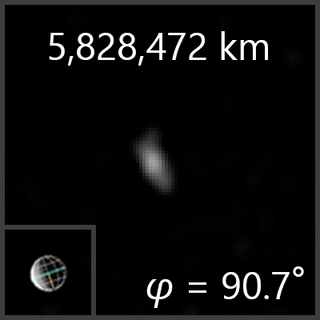Top Qs
Timeline
Chat
Perspective
Elara (moon)
Outer moon of Jupiter From Wikipedia, the free encyclopedia
Remove ads
Elara /ˈɛlərə/ is a prograde irregular satellite of Jupiter. It was discovered by Charles Dillon Perrine at Lick Observatory in 1905 in photographs taken with the 36" Crossley reflecting telescope which he had recently rebuilt.[1][8] It is the eighth-largest moon of Jupiter and is named after Elara, one of Zeus's lovers and the mother of the giant Tityos.[9]
Elara did not receive its present name until 1975; before then, it was simply known as Jupiter VII. It was sometimes called "Hera"[10] between 1955 and 1975. It has a mean radius of just 43 kilometres (27 mi), thus it is 2% of the size of Europa. However, it is half the size of Himalia, so it is the second-biggest moon in the Himalia group. It might be a captured type C or D asteroid, for it reflects very little light.
Elara belongs to the Himalia group, moons orbiting between 11 and 13 gigametres from Jupiter at an inclination of about 27.5°.[11] Its orbital elements are as of January 2000. They are continuously changing due to solar and planetary perturbations.
Remove ads
Discovery
Elara was discovered by Charles Dillon Perrine of the Lick Observatory on January 6, 1905, the day after the discovery of Himalia, also by Perrine, was announced. However, poor weather conditions delayed the confirmation of the discovery till the 21st of February.[12]
Exploration
New Horizons encounter
In February and March 2007, the New Horizons spacecraft to Pluto captured Elara in several LORRI images from a distance of 8 million km (5 million mi).[13]
See also
References
External links
Wikiwand - on
Seamless Wikipedia browsing. On steroids.
Remove ads

